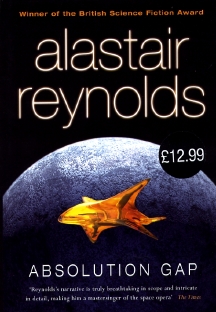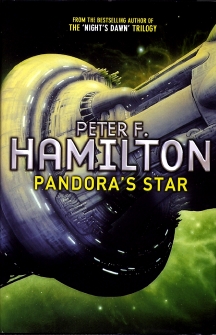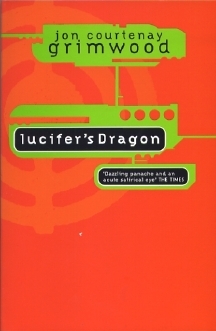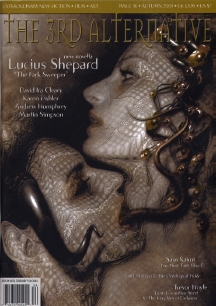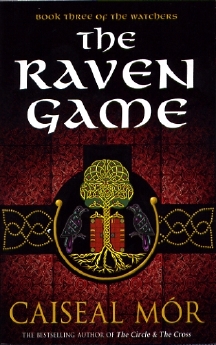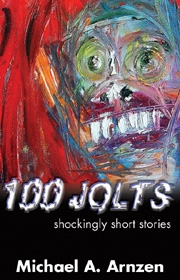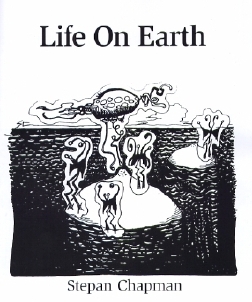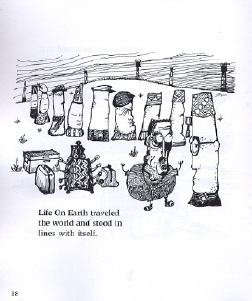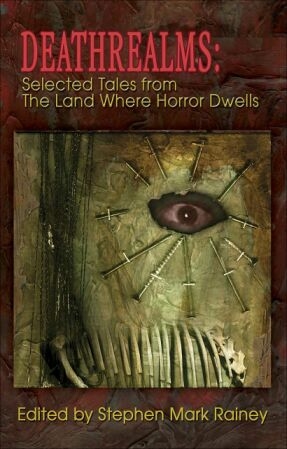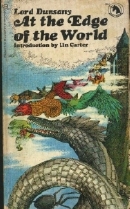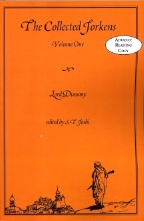|
|
|
This Just in..News from the Agony Column
01-29-04: Ending & Beginning with Alastair Reynolds and Peter F. Hamilton |
|||
Absolution
Gap Arrives
|
|
|
|
| The only blurb needed is the author's name. |
When I spoke with Alastair Reynolds during Worldcon 2002, he told me he had just started what was going to be the final book of his Inhibitors saga. As it happens, his first novel, 'Revelation Space', is the novel that brought me back to really enjoying the science fiction genre, after many years in which my feelings ranged from dislike to disinterest -- with exceptions, of course. Well, it's finally here, after a release late last year and an order with *.* for which I waited on delivery so that I could ship Reynoolds work with Rob Grant's 'Incompetence', Mary Gentle's '1610', Walter Jon Williams' 'The Sundering' and Steve Cockayne's 'The Iron Chain'. It was a very large box of books.
I don't know about my readers, but I loved the pig. Scorpio, an uplifted pig with human intelligence and porcine cunning was one of my favorite characters out of any recent science fiction work, and I find him starting the action in Reynolds' latest. Sporting a cover blurb that announces that Reynolds is a 'Winner of the British Science Science Fiction Award' and a bargain price, 'Absolution Gap' promises to be one of the big novels of this year, 2004, though it was released last year. In theory, Ace will bring out the US volume sometime this summer, and with both editions available within a single year, one hopes it will win a Hugo. Reynolds offers not only big ideas, a vast scope and wonderful characters, he also writes delightfully dense, lapidary prose.
As a reader, the experience of a Reynolds novel is often closer to that of reading an intricate haunted house novel than that of reading a big-brained science fiction work. Reynolds hits on all cylinders though. He's re-defined space battles in 'Redemption Ark' and he's written the dankest, drippingest mean-streets mystery I've ever read in 'Chasm City'. There's no doubt that this conclusion to a tense and powerful story will satisfy. The important question suggested by this book is: What will he do next? Reynolds has created a fascinating universe and science fiction writers are often loathe to leave their creations unexplored. Whatever universe he decides to invade with his words, I can guarantee that I will be there, eagerly awaiting his report.
|
|
|
| I'm going to try and see if I can get a jpg of this gatefold cover. |
He followed this up with a standalone, single volume space opera delight, 'Fallen Dragon', and the much more controversial -- and not well-received -- near future novel, 'Misspent Youth'. While the writing in and the concepts behind 'Misspent Youth' were both top-rate, Hamilton's earthbound characters were such petty, despicable scum that they challenged the reader's willingness to share the planet with them, let alone spend any time with them.
Fortunately, nobody's earthbound in his latest slab o' space opera, 'Pandora's Star'. Playing to his strengths, Hamilton depicts humanity in the year 2380 as having colonized over 600 planets. When a star far beyond the reach of man's technology disappears, apparently behind a force field of some kind, humanity decides it has to react. A faster-than-light ship is dispatched to find out what happened and why. But is that the wisest course of action? It's possible that we've just attracted the attention of that which would have been better left alone.
A glimpse at the interior of this novel found aliens of some kind playing a major part. For a monster movie guy like me, that's great news. At 882 pages, ' Pandora's Star' is the first of two parts in 'The Commonwealth Saga'. Yes, that's a Jim Burns cover, and yes, Richard Morgan, author of 'Altered Carbon' and 'Broken Angels' mentions that it involves the realms of faerie. Now that's the kind of all-inclusive, wide screen saga we like to see. With reality becoming ever more distressing, it's nice to know that in 375 years, we'll be able to worry about spaceships and stars. Even though some readers might feel as if it will take them that long to read about it!
|
0-00-04: Grimwood, Mor and TTA |
|||
The New Old Jon Courtenay Grimwood
As a US reader, I, like many others, find that attitude utterly frustrating and annoying. We do like to buy a lot of stupid fiction. But that's not all we like to buy, or read. Stupidity has its place. I don't want to read James Joyce's 'Ulysses' every day of my life, though I could in theory do so, and actually enjoy it. But I like the wide variety of fiction and non-fiction. Novels can be simple and straightforward without being dumb; George P. Pelecanos writes novels with a fairly simple storyline. They’re certainly not dumb. And hey, dumb fun has its place. Both Terry D'Auray and I quite enjoyed Simon R. Green's 'Something from the Nightside'. It's not going to win a Nobel Prize, but it might amuse the hell out of you after you finish up an intense bout of reading Pete Dexter's 'Train' and Jonathan Lethem's 'The Fortress of Solitude'. So we buy dumb stuff because we also read a lot of smart stuff. Books offer the widest range of entertainment possible; that's one of the reasons to read. Now that the entire publishing industry has been informed, I'm sure we can expect a sea change any minute now. But in the interim, you at least have the option of getting Jon Courtenay Grimwood's second novel, 'Lucifer's Dragon' in a snappy-looking re-issue from Simon & Schuster, via Pocket Books, where all the Earthlight (a great imprint, now sadly missed) authors have gone. 'Lucifer's Dragon' is a neon-orange thriller about a mafia daughter who re-builds Venice in the middle of the Pacific Ocean. A century later, the daughter of a noble in New Venice immerses herself in a virtual reality game which begets violence in the real world. (This scenario is not unlike that found in the essay 'Gruppenfuhrer Louis XIV', a non-existant book reviewed by Stanislaw Lem in 'A Perfect Vacuum'. In the reviewed book, an SS officer decides to rebuild the world of the Sun King in the deep jungles of South America with stolen Nazi gold.) We can look to Courtenay to provide us with gritty neon noir and superior prose in an ultra-dense mystery. And we'll enjoy the hell out of it. Because we are not, after all, stupid. |
|||
The
First Third
From the cover you can clearly see that they're not just dishing here. This issue includes a new novella by Lucius Shepard and several short stories with effective, intriguing illustrations. The design work behind Martin Simpson's story 'Phantom Limb' by Edward Noon is quite striking. Figure in a column on movies by one of my favorite under-found-in-the-USA horror writers, Christopher Fowler, a nice introductory rant on genrification by all-star Justina Robson and you have another way to send your money out at a speed much higher than that at which it manages to come in. |
|||
Celtic
Relief from Caiseal Mor
|
|
01-27-04: Michael Arnzen's 100 Jolts, Stepan Chapman's Polemic Chapbook, The Best of Deathrealm |
||||||
100
Jolts by
Michael Arnzen
What Arnzen writes are "gorelets". From his web page at gorelets.com: "Gorelets are "sudden horror poems" and "dark microfiction." You might think of them as bite-sized nuggets of noir. Tiny caplets of terror. Short sharp shockers designed to make you squirm. They are uniquely short and scary and strange."
|
||||||
Stepan Chapman's Chapbook Polemic
News is here to show you pretty pictures. If you spring for Chapman's chapbook, and I think you should, here is just about 5% of what you'll get. The other 95% is the same, only different. I guarantee that whoever is in the room with you when you open up the envelope will be hearing Chapman's words from your mouth shortly after the unveiling. Hope they're patient and not too annoyed that another visit to the Agony Column brought this space rock down out of its very eccentric orbit. |
||||||
The
Best of Deathrealm
Given Delirium's proven record, I'm happy to see that they'll be releasing a hardcover edition of Mark Rainey's 'Best of Deathrealm' anthology, and not the least because I have a long and distressing story in it. Mark just sent me a copy of the cover, and I'm bringing it to you. It's very nice, and I'm looking forward to the finished product. With all this short fiction about, I'm going to have to re-align my reading priorities. In fact, I already have. I'm now officially reading Crimewave 7, edited by Andy Cox, 'Bibliomancy' , a collection of novellas by Elizabeth Hand and 'Rumpole and the Primrose Path' by John Mortimer, as well as the vicious novel 'Market Forces', by Richard Morgan. Where will all this short fiction lead to? Probably a breakdown of essential services and civil disorder. |
|
01-26-04: Re-Mystifying Reality |
|||||||||||
Re-Mystifying
Reality With
Night Shade Books' new 3 Volume set of 'The Collected Jorkens' by
Lord Dunsany
Nightshade Books, which seems intent on world conquest, and well-informed enough to do so, is embarked on a series of reprints from their wonderful William Hope Hodgson to their latest venture, Lord Dunsany. I just got an advance copy of the first of a three-volume series of Lord Dunsany's 'Jorkens' stories. The Jorkens stories are traveler's tales that take much of their inspiration from Dunsany's own travels around the world. They're funny, weird and very hard to find. Nightshade's first volume includes the kind of extras you really want to have: a "Brief Forward" by Edward Plunkett, the current Lord Dunsany, written at Dunsany Castle in April, 2003.
You also get a lengthy and loving introduction to the work of Dunsany by none other than Arthur C. Clarke. He talks about encountering the work of Dunsany, just as many of us encountered both Clarke and Dunsany contemporaneously in our youth. It's important to note that J. R. R. Tolkien might also have encountered Dunsany's work in his youth. It's fascinating to see the layers of literary inspiration the lie beneath today's writing. And finally, you get the scholarly talents of S. T. Joshi, who talks about the core of the Jorkens tales. It's interesting because it applies directly to today's fascination with alternate history. What Dunsany wanted to do in his Jorkens tales, according to Dunsany's own introduction, was to "advance the Progress of Science" and to "add something of a strangeness to parts of our planet, just as it was tending to grow too familiar." These goals aren't really complementary. Joshi suggests, "...the latter is clearly what Dunsany was getting at." This of course fits with his typical identification as a fantasist.
|
